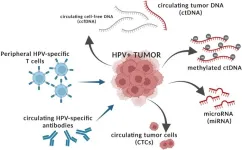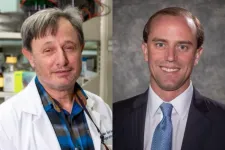Scientists outline a new strategy for understanding the origin of life
2023-08-14
(Press-News.org)
Despite decades of progress, the origin of life remains one of the great unsolved problems in science. “The most basic features of biology, that organisms are made of cells, that they pass genetic information through DNA, that they use protein enzymes to run their metabolism, all emerged through specific processes in very early evolutionary history,” says Aaron Goldman, Associate Professor of Biology at Oberlin College. “Understanding how these most basic biological systems first took shape will not only give us greater insight into how life works at the most fundamental level, but what life actually is in the first place and how we might look for it beyond Earth.”
The question of how life first emerged is typically studied through laboratory experiments that simulate early Earth environments and look for chemistries that can create the same kinds of biomolecules and metabolic reactions that we see in organisms today. This is known as a “bottom-up” approach since it works with materials that would have been present on the prebiotic Earth. While these so-called “prebiotic chemistry” experiments have successfully demonstrated how life may have originated, they cannot tell us how life actually did originate. Meanwhile, other research uses techniques from evolutionary biology to reconstruct what early life forms might have looked like based on data from life today. This is known as the “top-down” approach and can tell us about life’s history on Earth. Top-down research, however, can only look as far back as there were genes that are still conserved in organisms today, and therefore not all the way to the origin of life. Despite their limitations, top-down and bottom-up research are aiming at the common goal of discovering life’s origins, and ideally their answers should converge on a common set of conditions.
A new article published by Goldman, Laurie Barge (Research Scientist in Astrobiology at NASA’s Jet Propulsion Laboratory (JPL)), and colleagues, attempts to bridge this methodological gap. The authors argue that combining bottom-up laboratory research on plausible pathways toward an origin of life with top-down evolutionary reconstructions of early life forms can be used to discover how life truly did originate on the early Earth. In their article, “Electron Transport Chains as a Window into the Earliest Stages of Evolution” the authors describe one phenomenon central to life today that could be studied by combining both bottom-up and top-down research: electron transport chains.
Electron transport chains are a type of metabolic system that is used by organisms across the tree of life, from bacteria to humans, to produce usable forms of chemical energy. The many different types of electron transport chains are specialized to each form of life and the energy metabolism they use: for example, our mitochondria contain an electron transport chain linked to our heterotrophic (food-consuming) energy metabolism; whereas plants have a wholly different electron transport chain linked to photosynthesis (the generation of energy from sunlight). And across the microbial world, organisms use a broad range of electron transport chains linked to a variety of different energy metabolisms. But, despite these differences, the authors describe evidence from top-down research that this kind of metabolic strategy was used by the very earliest life forms and they present several models for ancestral electron transport chains that could date back to very early evolutionary history. They also survey current bottom-up evidence suggesting that even before the emergence of life as we know it, electron transport chain-like chemistry could have been facilitated by minerals and early Earth ocean water. Inspired by these observations, the authors outline future research strategies that synthesize top-down and bottom-up research on the earliest history of electron transport chains in order to gain a better understanding of ancient energy metabolism and the origin of life more broadly.
This study is the culmination of five years of previous work by this multi-institute interdisciplinary team led by Barge at JPL, which was funded by the NASA-NSF Ideas Lab for the Origins of Life to study how metabolic reactions could have emerged in geological settings on the early Earth. Previous work by the team has investigated, for example, specific electron transport chain reactions driven by minerals (led by Jessica Weber, JPL Research Scientist); how ancient enzymes may have incorporated prebiotic chemistry in their active sites (led by Goldman); and microbial metabolism in extremely energy-limited environments (led by Doug LaRowe, at the University of Southern California). “The emergence of metabolism is an interdisciplinary question and so we need an interdisciplinary team to study this,” says Barge. “Our work has utilized techniques from chemistry, geology, biology, and computational modeling, to combine these top-down and bottom-up approaches, and this kind of collaboration will be important for future studies of prebiotic metabolic pathways.”
END
ELSE PRESS RELEASES FROM THIS DATE:
2023-08-14
A deafened adult cannot recover the ability to hear, because the sensory hearing cells of the inner ear don’t regenerate after damage. In two new studies, partially funded by the National Institutes of Health and published in the Proceedings of the National Academy of the Sciences (PNAS), USC Stem Cell scientists explain why this is the case and how we might be able to change it.
“In the non-sensory supporting cells of the inner ear, key genes required for conversion to sensory cells are shut off through a process ...
2023-08-14
Government legislation to flag and moderate dangerous content on social media can be effective in reducing harm, even on fast-paced platforms such as X (formerly Twitter) new research shows.
Social media posts such as those that promote terrorism and hate, dangerous challenges that put teen lives at risk, or those that glamorise suicide, pose a significant threat to society. And this harm spreads exponentially, like an infectious disease.
Dr Marian-Andrei Rizoiu from the University of Technology Sydney (UTS) Behavioural Data Science Lab and Philipp J. Schneider from École Polytechnique Fédérale de Lausanne harnessed ...
2023-08-14
Older adults who play digital puzzle games have the same memory abilities as people in their 20s, a new study has shown.
The study, from the University of York, also found that adults aged 60 and over who play digital puzzle games had a greater ability to ignore irrelevant distractions, but older adults who played strategy games did not show the same improvements in memory or concentration.
It is known that as humans age, their mental abilities tend to decrease, particularly the ability to remember a number of things at a single time - known as working memory. Working ...
2023-08-14
Inoue Receives Funding For Mason CARES Plus
Megumi Inoue, Associate Professor, Social Work, received funding for: "Mason CARES Plus."
Mason CARES Plus is an expansion study to Mason CARES that will focus on conducting in-depth focus groups and online semi-structured interviews to assess which specific aspects of the Stress Busting Program (SBP) and the Music and Memory program (M&M) were most (and least) impactful in reducing care partner stress and identify effective strategies to improve care partner engagement with the M&M program among Mason CARES participants.
Preliminary results from the Mason CARES study show a high ...
2023-08-14
Hopping in the shower, we anticipate the warm water to be cleansing and renewing after a long, hard day — but there may be something dangerous lurking in the showerhead.
Showers can expose us to many types of bacteria cells. Most are harmless, but some – called drinking water-associated pathogens of the immunocompromised (DWPIs) – can pose a serious risk to our health, especially for individuals with weakened immune systems.
Sarah Haig, Assistant Professor of Civil and Environmental Engineering at the University of Pittsburgh Swanson School of Engineering, received $420,000 from the National Science Foundation ...
2023-08-14
Boston, MA - New research led by Boston Medical Center and Boston University School of Public Health found that children who received integrated mental health care showed improvements in both mental health and school performance. These findings, published in the Journal of Developmental & Behavioral Pediatrics, examined changes over time in outcomes among 6-12-year-old children receiving integrated behavioral health care at three federally qualified health centers (FQHCs) that implemented the TEAM UP Model of care.
The study, which included 51 children serviced ...
2023-08-14
“We discuss existing clinical data on these surrogates of tumor burden and their potential in evaluating efficacy of immunotherapy in HPV-associated malignancies.”
BUFFALO, NY- August 14, 2023 – A new review paper was published in Oncotarget's Volume 14 on August 10, 2023, entitled, “Peripheral surrogates of tumor burden to guide chemotherapeutic and immunotherapeutic strategies for HPV-associated malignancies.”
With the rapid adoption of immunotherapy into clinical practice for HPV-associated ...
2023-08-14
When it comes to translational medicine, Robert Gourdie is among the 2 percent of “super-producers,” National Institutes of Health-funded scientists at U.S. biomedical institutions who hold 10 or more issued patents.
Super-producers were responsible for half of all patents issued according to research published Aug. 11 in Nature Biotechnology. The objective of the research was to create a tool to better quantify bridges and barriers to clinical translation of biomedical discoveries.
The research marks a novel area of inquiry for Gourdie, a professor and cell biologist at the Fralin Biomedical ...
2023-08-14
In the rush to harness artificial intelligence and machine learning tools to make care more efficient at hospitals nationwide, a new study points to another possible use: identifying patients with non-medical needs that could affect their health and ability to receive care.
These social determinants of health – everything from transportation and housing to food supply and availability of family and friends as supports – can play a major role in a patient’s health and use of health care services.
The new study ...
2023-08-14
A new study from clinicians and researchers at the University of Michigan Rogel Cancer Center, U-M Department of Pathology and the Michigan Center for Translational Pathology reveals findings from over 800 clinical assays performed for kidney patients with MiTF family gene mutations. This study, published in the American Journal of Clinical Pathology¸ is the largest series of its kind in kidney cancer and carries deep clinical and diagnostics implications.
The team, led by Rohit Mehra, M.D., performed over 800 clinical assays on the MiTF family genes TFE3 and TFEB in renal tumors with morphologic and biomarker alterations considered suspicious for MiTF family genetic mutations.
The ...
LAST 30 PRESS RELEASES:
[Press-News.org] Scientists outline a new strategy for understanding the origin of life


